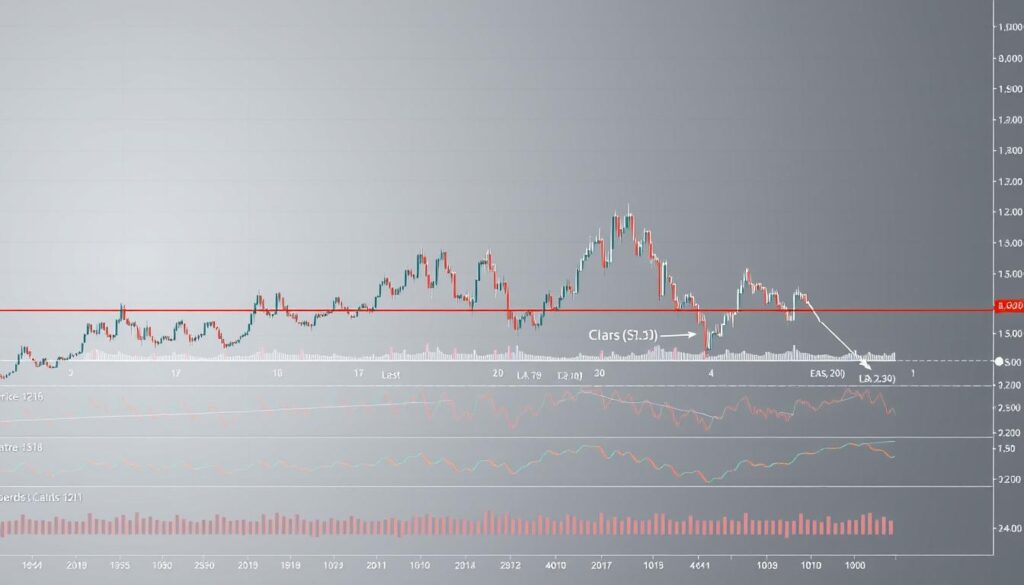Now Reading: Market Correction Crypto Buy Opportunity: What You Need to Know
- 01
Market Correction Crypto Buy Opportunity: What You Need to Know
Market Correction Crypto Buy Opportunity: What You Need to Know

Have you watched digital asset prices fall and wondered what to do? A temporary price decline can actually be a strategic moment for investors. This approach focuses on finding favorable entry points when others are nervous.
The digital asset landscape recently saw a major shift. Total valuation dropped significantly, creating a sense of alarm for some. For experienced traders, however, this movement presented a different picture.
This guide will help you understand these price movements. You will learn how to identify them and leverage them strategically. We will turn a potentially unsettling event into a calculated opportunity.
The article covers the differences between various downturns. You will gain the knowledge to distinguish a temporary setback from a more serious trend change. We will also explore practical strategies like dollar-cost averaging and risk management designed for volatile conditions.
Remember, these periods are a normal part of any financial landscape. Historically, they have often been followed by recoveries. With the right knowledge, you can navigate these waters with confidence.
Understanding the Crypto Market Correction
Periods of declining valuations in the digital asset space often create confusion among investors about proper strategy. Recognizing different types of price movements helps develop effective approaches.
Defining Crypto Market Corrections
A crypto market correction represents a temporary price decline typically between 5% and 20% from recent highs. This movement serves as a natural cooling-off phase after significant appreciation.
These adjustments function as self-regulating mechanisms that prevent speculative bubbles. They contribute to overall stability despite causing short-term uncertainty.
| Event Type | Price Decline | Duration | Market Sentiment |
|---|---|---|---|
| Correction | 5-20% | Days to weeks | Temporary concern |
| Bear Market | 20%+ | Months to years | Persistent pessimism |
| Market Crash | 20%+ suddenly | Hours to days | Extreme panic |
Differences Between Corrections, Bear Markets, and Crashes
Corrections differ significantly from more severe downturns. During a correction, the overall bullish trend typically remains intact with quick recovery potential.
Bear markets involve prolonged declines with persistent negative sentiment. Crashes occur suddenly due to specific events or extreme selling pressure.
Market Correction Crypto Buy Opportunity: How to Leverage Discounted Assets
Navigating a downward trend requires a clear strategy to identify undervalued digital holdings. For seasoned participants, these phases are not setbacks but chances to accumulate quality tokens at more attractive valuations.
Pinpointing the perfect moment to enter a position is challenging. Even experts rarely catch the absolute bottom. Instead of trying to time a single entry, a phased approach often yields better results.
Identifying the Optimal Entry Points
Successful identification involves analyzing several technical and fundamental signals. Key support levels, where an asset’s price has historically reversed, are crucial areas to watch.
Volume analysis provides another vital clue. A decline in selling pressure can indicate that the downward momentum is weakening. This often signals a potential reversal zone.
| Signal Type | What to Look For | Potential Action |
|---|---|---|
| Support Level Test | Price approaches a historical support zone and holds. | Consider initiating a small position. |
| Volume Divergence | Price drops further, but selling volume decreases. | Indicates weakening sell-side pressure; a potential entry. |
| Holder Accumulation | Long-term wallets increase their balances during the dip. | A strong bullish signal from confident participants. |
Preparation is essential. Maintaining a reserve of stable assets allows one to act quickly when prices align with their strategy. This discipline to acquire when sentiment is negative is a hallmark of a strategic approach.
It is also critical to focus on fundamentally sound projects. Not every depreciating asset represents a good deal. Prioritize those with strong use cases and active development.
Causes and Triggers Behind Crypto Corrections
Understanding what sparks a price decline is crucial for maintaining a clear perspective. These events are rarely caused by a single factor.
Instead, they result from a complex mix of external news, internal market mechanics, and powerful human emotions.

Market Psychology and FUD Factors
Emotions like fear and uncertainty can drive prices as much as fundamentals. During a downturn, negative sentiment spreads quickly.
This phenomenon, often called FUD (Fear, Uncertainty, and Doubt), becomes a self-fulfilling prophecy. Panic selling leads to lower prices, which creates more panic.
Herd behavior takes over. Many participants follow the crowd’s actions instead of their own research. This amplifies price movements in both directions.
| Trigger Category | Specific Example | Market Impact |
|---|---|---|
| Regulatory News | Government announcements about new rules. | Creates widespread uncertainty and selling pressure. |
| Macroeconomic Shifts | Rising inflation fears in traditional finance. | Triggers a “risk-off” mentality, affecting digital assets. |
| Technical Factors | Mass liquidations of leveraged trades. | Forced selling creates a rapid, cascading price drop. |
Technical factors also play a major role. A sharp drop can trigger a chain reaction. When leveraged positions get liquidated, it forces more selling.
Algorithmic trading systems can accelerate this process. They sell automatically when key price levels break. For a deeper look at managing these situations, explore our guide on effective crypto strategies.
These changes are a natural part of the asset cycle. Recognizing the causes helps investors stay calm and strategic during volatile periods.
Recognizing Key Price Movements and Technical Indicators
Successful navigation of asset cycles hinges on the ability to spot the difference between a temporary pullback and a lasting trend change. This skill separates reactive investors from strategic ones.
Accurate interpretation of technical data provides the necessary context. It helps you understand the underlying strength or weakness of a move.

Identifying New Highs and Lows
Chart patterns reveal the market’s true story. During a healthy phase, an asset will often establish a series of higher lows.
This pattern indicates that buyers are stepping in at progressively elevated levels. A break from this structure, forming lower highs and lower lows, signals a potential reversal.
Observing how price reacts at established support zones is critical. A bounce confirms strength, while a decisive break suggests a deeper shift.
Monitoring Trading Volume and Sentiment
Trading volume offers vital clues about conviction. A decline with fading volume often points to seller exhaustion.
In contrast, a downtrend with sustained or increasing volume indicates strong selling interest. This can be a sign of a more significant change.
Sentiment tools, like fear and greed indexes, add another layer of data. They help gauge whether panic is temporary or fundamental.
Combining these signals with a comprehensive trend analysis creates a powerful framework. It allows you to act on logic, not emotion, in volatile markets.
How to Develop a Crypto Trading Strategy During Corrections
A solid plan created during calm periods becomes your most valuable tool when volatility strikes. Emotional decisions often lead to poor outcomes. A clear trading strategy provides a rational framework to follow.
This approach removes guesswork and panic from the process. It helps investors stick to a logical plan.

Implementing Dollar-Cost Averaging (DCA)
Dollar-cost averaging is a powerful method for long-term crypto trading. You invest a fixed amount of money at regular intervals. This happens regardless of the current price.
The system automatically buys more units when prices are low. It buys fewer when prices are high. This results in a lower average cost over time.
Trying to find the perfect entry point is extremely difficult. DCA removes the need to time the bottom perfectly.
Crafting Rules for Automated Trading Bots
Automation ensures your strategy executes without emotional interference. Bots can be programmed for a dollar-cost averaging plan. They place buy orders at set times and prices.
Your rules should define position size, entry triggers, and exit criteria. Personalize these rules based on your risk tolerance and goals.
| Strategy Element | Manual Execution | Automated Bot Execution |
|---|---|---|
| Consistency | Relies on investor discipline | Programmed for unwavering consistency |
| Emotional Control | Subject to human emotion | Emotionless, follows code exactly |
| Time Efficiency | Requires active monitoring | Operates 24/7 without supervision |
A written plan is essential for successful trading. It turns panic into purposeful action.
Risk Management Techniques for Market Volatility
The foundation of sustainable participation in volatile environments lies in risk control protocols. Proper techniques protect capital while allowing strategic positioning during price swings.

Effective risk management separates successful investors from those who suffer catastrophic losses. It creates a safety net that preserves your ability to continue trading.
Setting Effective Stop-Loss Orders
Stop-loss orders automatically sell positions when assets reach predetermined price levels. This prevents small declines from becoming devastating losses if the downturn deepens.
Trailing stop-loss orders offer dynamic protection by adjusting upward as values rise. They lock in profits while allowing positions to benefit from continued appreciation.
Place these orders below key support levels identified through technical analysis. This avoids being stopped out by normal fluctuations during temporary pullbacks.
Position sizing determines how much capital to allocate to each trade. Limit single positions to 2-5% of your total portfolio value to prevent overexposure.
Maintain cash reserves of 10-20% in stable assets. This provides flexibility to acquire more during price drops without selling current holdings at unfavorable prices.
Take-profit orders complement stop-losses by automatically securing gains at target levels. Together, they remove emotion from decisions during periods of crypto market volatility.
Accept that not every trade will be profitable. Proper risk management ensures losses remain controlled and don’t jeopardize your overall portfolio survival.
Harnessing Automated Trading and Crypto Trading Bots
When emotions run high during price swings, algorithmic tools offer a disciplined alternative. These systems operate on predefined rules rather than human feelings.
Trading bots provide significant advantages in uncertain conditions. They execute decisions based on data analysis instead of emotional reactions.
Benefits of Trading Bots in a Volatile Market
Automated systems monitor digital asset exchanges continuously without fatigue. This 24/7 operation is crucial in the always-active cryptocurrency environment.
These tools eliminate emotional decision-making that often leads to poor outcomes. They process multiple technical indicators simultaneously and react instantly to movements.
Optimizing Bot Strategies for Corrections
Investors must create carefully-crafted approaches for their automated assistants. Platforms like Cryptohopper and Bitsgap offer comprehensive strategy designers.
Optimizing for volatile periods involves configuring tighter risk controls and conservative position sizing. Backtesting functionality allows validation against historical data before implementation.
While crypto trading bots offer powerful advantages, they require proper configuration and periodic review. A well-designed automated strategy can navigate challenging conditions effectively.
Approaches to Data Analysis and Trend Monitoring in Crypto
Making smart decisions in volatile digital asset environments requires a solid foundation in data analysis. This process combines multiple information sources to distinguish temporary dips from significant shifts.
Effective analysis blends technical indicators, on-chain metrics, and historical patterns. This multi-layered approach helps identify when assets are genuinely undervervalued.
Leveraging Technical Indicators and Historical Data
Tools like the Relative Strength Index (RSI) and Moving Average Convergence Divergence (MACD) are vital. They help spot oversold conditions during price declines.
Historical data reveals consistent recovery patterns. Bitcoin saw multiple 20-50% pullbacks in 2021, each followed by new highs.
Candlestick patterns offer visual clues about investor psychology. Formations like hammer patterns often signal potential reversal points.
On-chain data provides unique insights into holder behavior. Monitoring exchange flows shows whether long-term investors are accumulating or selling.
Analyzing trends across weekly and monthly charts provides better perspective. This helps filter out short-term noise in the markets.
Combining these signals creates more reliable analysis. Confirmation from different technical indicators increases confidence in your assessment.
Backtesting strategies against past data is crucial. It lets you refine approaches before using real capital in current markets.
Long-Term Investment Strategies in Bear Markets and Corrections
Historical patterns reveal that those who maintain conviction during downturns typically achieve superior results. The most successful investors view price decline as a chance to accumulate quality assets.
During the May 2021 bear market, data showed 75% of Bitcoin supply remained profitable despite the significant drop. This demonstrates the resilience of well-timed acquisitions.
Balancing Active Trading and Passive Holding
Smart crypto investors maintain a core portfolio of high-conviction assets. They allocate a smaller portion for tactical moves during corrections.
This balanced strategy allows participation in short-term movements while preserving long-term positions. It combines the benefits of both approaches.
Rebalancing Your Portfolio for Future Growth
Portfolio rebalancing during market downturns involves assessing allocation percentages. Assets that held up well become overweighted.
Those that declined significantly become underweighted. Adjusting back to target percentages enforces disciplined accumulation.
This approach naturally implements buying low and selling high. It positions the portfolio for recovery when the bear phase ends.
Successful investors focus on fundamental developments rather than short-term price movements. Their strategy remains consistent through various market conditions.
Learning from Historical Market Correction Trends
Examining past price movements gives investors crucial insights into how digital asset cycles typically unfold. These patterns reveal consistent behaviors and recovery timeframes across different periods.
The May 2021 event serves as an informative case study. The total market capitalization plunged from $2.5 trillion to $1.4 trillion in just seven days.
Case Studies and Lessons Learned
This sharp decline saw Bitcoin fall 53% from its peak. Ethereum experienced a similar drop during the same volatile weeks.
Before the downturn, money rotated from Bitcoin into other assets. This created overheated conditions that preceded the significant drop.
Short term holders largely drove the selling pressure. Meanwhile, institutional investors accumulated positions at lower price levels.
Despite the price decline, fundamental network metrics actually reached new highs. This data showed underlying strength despite surface volatility.
Multiple catalysts converged to trigger this movement. The markets eventually recovered as these temporary factors faded.
Historical trends teach us that recovery patterns vary. However, crypto markets have consistently rebounded when fundamental adoption continues.
Conclusion
Digital asset investors who master volatility often find the most rewarding outcomes. Temporary price changes are a regular feature, not a flaw, in this dynamic landscape.
Successful navigation hinges on preparation. Strategies like dollar-cost averaging and automated tools help make rational decisions when fear and uncertainty spike.
History shows that periods of decline are frequently followed by robust recoveries. The long-term trend for blockchain technology and cryptocurrencies remains powerfully positive.
Viewing a market correction as a strategic opportunity, rather than a threat, is a hallmark of a disciplined approach. This mindset turns volatility into an advantage.











